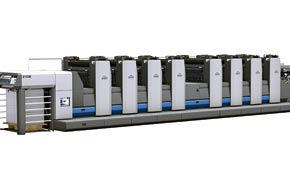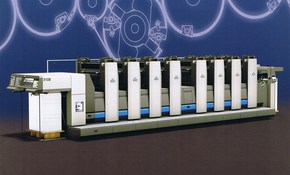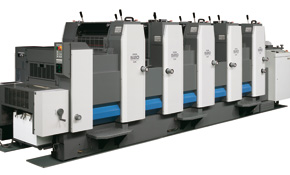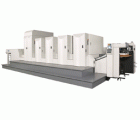
When was the machine launched and what market is it aimed at?
Ryobi quickly followed up the launch of the 920 at last year’s Ipex with a perfect-ing version in the autumn. Bernard Cheong, managing director of local reseller Cyber, says the SRA1 press is ideal for B2 magazine printers that are looking to offer eight-up printing on both sides but don’t want to invest in a B1 press.
He says 95-100% of commercial work that goes through Australian B1 presses is actually SRA1. “Use the 80:20 rule: you want to maximise your profit for 80% of your work. For 20% of the less profitable work, you can always send it out, as a service to your customer. In this case, the amount of SRA1 work becomes about 99% for most customers,” he says, calling a Ryobi 920 investment “a no-brainer”.
How does it work?
Design for both the 920 and 920P is based on Ryobi’s tried-and-trusted 750 B2 press, which has been around since Ipex 2002. Like all Ryobi models, it has double-diameter impression cylinders set at seven o’clock to the blanket cylinder. These larger cylinders mean the sheet is fully printed before entering the transfer cylinder, reducing the chance of the sheet being scuffed or marked.
The 920P can handle a range of paper thicknesses from 0.04mm onion skin right up to heavy 0.6mm card stock. LED-UV curing, which can sit at both the perfecting device and press delivery to cure both sides of the sheet, is an optional extra. Other extras include paper size preset and impression pressure preset systems, and printing density control.
What’s its USP?
Size matters to Ryobi, and the SRA1 format means the press costs less and is cheaper to run than a standard B1 press. Cheong says the machine is almost the same price as a fully spec’d Heidelberg XL 75, a half-size press. He argues that the Ryobi machine reduces costs in other ways too. He says it can help cut the power bill by 37% and plate costs are down 27%.
Its compact footprint frees up space in the pressroom as well. Cheong says there is a 37% space saving. Other manufacturers argue, however, what you gain on format efficiency, you lose on flexibility.
How quick is it and what is the quality like?
Running at 16,200 sheets per hour, the 920P holds its own against its B1 rivals. To aid quality, the press is equipped with a tape slowdown mechanism as well an underswing gripper and drop-away front-lay in-feed system, all of which keep registration accurate at high speeds. Ryobi’s Ink Volume Setter (IVS) software connects the pre-press directly through to the off-press control console and presets the ink ducts.
Cheong says this “artificial intelligence” function will automatically make adjustments after every completed job, so that over time, the colour setting from the IVS software will be almost 100%. Running from a Windows PC, IVS can be independent or piggybacked onto an existing RIP.
How easy is it to use?
All main press controls are housed on the off-press console, and Cheong says that Komori or Heidelberg operators can “get production up and going without training”.
“All you need is common sense. Usually two days is enough for a standard press, though every situation is different.”
What level of service can printers expect?
Cyber keeps a range of Ryobi press spares at its Australian parts warehouse in Sydney, with further back-up in Singapore. Cheong say that the worst-case scenario would be to get parts shipped from Ryobi HQ in Japan, which should take three days by courier. He adds that “due to the geographical nature of Australia”, Cyber works with a network of more than 40 contract engineers across Australia.
“These are very experience engineers, and most of them had received factory training in Japan. Customers can access remote diagnostics from Cyber in Singapore and Ryobi in Japan.”
What does it cost and is there a sales target?
A typical five-colour 925 perfector model starts at $1.35m and up, depending on the optional extras. For a 925 with aqueous coater, the cost is around $1.6m. Cheong points out that there are more than 120 different configurations available. The first 925 in Australia and New Zealand was installed in 2006, and Cheong says his company has installed around four presses per years since then. Cyber has notched up more than 100 printing units in ANZ, across 20 presses. A 10-colour Ryobi perfector is due to be installed in August.
Specifications
Max paper size: 920x640mm
Min paper size: 410x290mm
Max printing area: 900x615mm
Speed: 16,200sph
Number of units: 2-10 including perfecting
Paper thickness: 0.04-0.6mm
Price: Starts from $1.35m
Contact: Cyber (02) 9318 0099
Comment below to have your say on this story.
If you have a news story or tip-off, get in touch at editorial@sprinter.com.au.
Sign up to the Sprinter newsletter



